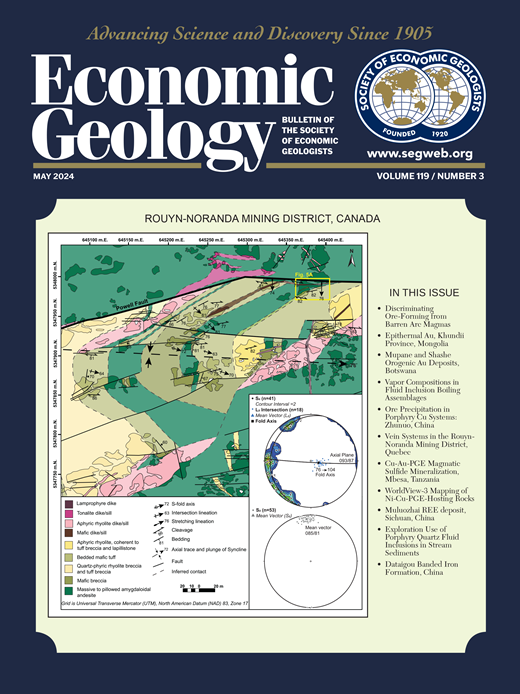巨型铜斑岩矿床及其伴生的碧玺角砾岩管的化学和反射光谱鉴别碧玺种类:检验碧玺作为矿物载体
IF 5.5
1区 地球科学
Q1 GEOCHEMISTRY & GEOPHYSICS
引用次数: 0
摘要
A.M.角砾岩是不列颠哥伦比亚省南部巨型铜斑岩矿床的一部分。这是在加拿大科迪勒拉唯一的明确带状碧玺角砾岩管。电气石是A.M.角砾岩中常见的蚀变矿物,在空间上与铜成矿作用有关。电气石化学性质的变化范围从碱(榴辉石-钙辉石)到钙(阿魏石-钙辉石)。电气石亚种根据其在A.M.角砾岩中的空间位置而变化。管道外的碧玺含有较高浓度的镁,而管道内的碧玺则优先与铁结合。这些化学变化在手部标本中难以区分。通过对587颗碧玺颗粒的光谱反射率数据进行收集,以确定是否可以基于现场来识别碧玺的化学变化,从而提高成本效益。光谱反射率可区分与矿化和角砾岩结构相关的碧玺,与出现在管道接触远端或出现在贫瘠的碧玺角砾岩管道中的碧玺。A.M.角砾岩中的富铁碧玺具有富铁端元谱特征。在A.M.角砾岩远端和在贫瘠管道内的碧石表现出端部驱动岩的光谱(富镁)。这种分组表明,电气石亚种可以通过光谱反射率推断,提高了电气石作为矿物矢量的效率。电气石也通过航空光谱测量确定。然而,航空光谱测量没有识别出原位分析确定的端元光谱特性。航空光谱测量可以快速识别电气石角砾岩管道暴露,加快电气石为已知脉石矿物的矿区的早期勘探。本文章由计算机程序翻译,如有差异,请以英文原文为准。
DIFFERENTIATING TOURMALINE SPECIES VIA CHEMISTRY AND REFLECTANCE SPECTROSCOPY AT THE GIANT COPPER PORPHYRY DEPOSIT AND ASSOCIATED TOURMALINE BRECCIA PIPES: TESTING TOURMALINE AS A MINERAL VECTOR
The A.M. breccia is part of the Giant Copper porphyry deposit in southern British Columbia. It is the only well-defined zoned tourmaline breccia pipe in the Canadian Cordillera. Tourmaline is a common alteration mineral within the A.M. breccia and is spatially associated with Cu mineralization. Observed changes in tourmaline chemistry range from alkali (schorlitic-dravitic) to calcic (feruvitic-uvitic). Tourmaline subspecies vary based on their spatial location within the A.M. breccia. Tourmaline outside of the pipe contains higher concentrations of Mg, whereas tourmaline preferentially incorporates Fe within the pipe. These chemical variations are indistinguishable in hand specimens. Spectral reflectance data were collected from 587 tourmaline grains to determine if discerning chemical changes in tourmaline can be made field-based and thus more cost-effective. Spectral reflectance differentiates tourmaline associated with mineralization and breccia textures from tourmaline occurring distal to the pipe contact or within barren tourmaline breccia pipes. Fe-rich tourmaline within the A.M. breccia shows spectral characteristics of end-member schorl (Fe-rich) spectra. Tourmaline distal to the A.M. breccia and within barren pipes demonstrates spectra of end-member dravite (Mg-rich). This grouping suggests that tourmaline subspecies can be inferred by spectral reflectance, enhancing the efficiency of tourmaline as a mineral vector.
Tourmaline was also identified via airborne spectral surveys. However, the airborne spectral survey did not identify the end-member spectral properties identified by in situ analysis. Airborne spectral surveys can rapidly identify tourmaline breccia pipe exposures and expedite early stages of exploration in ore districts where tourmaline is a known gangue mineral.
求助全文
通过发布文献求助,成功后即可免费获取论文全文。
去求助
来源期刊

Economic Geology
地学-地球化学与地球物理
CiteScore
10.00
自引率
6.90%
发文量
120
审稿时长
6 months
期刊介绍:
The journal, now published semi-quarterly, was first published in 1905 by the Economic Geology Publishing Company (PUBCO), a not-for-profit company established for the purpose of publishing a periodical devoted to economic geology. On the founding of SEG in 1920, a cooperative arrangement between PUBCO and SEG made the journal the official organ of the Society, and PUBCO agreed to carry the Society''s name on the front cover under the heading "Bulletin of the Society of Economic Geologists". PUBCO and SEG continued to operate as cooperating but separate entities until 2001, when the Board of Directors of PUBCO and the Council of SEG, by unanimous consent, approved a formal agreement of merger. The former activities of the PUBCO Board of Directors are now carried out by a Publications Board, a new self-governing unit within SEG.
 求助内容:
求助内容: 应助结果提醒方式:
应助结果提醒方式:


